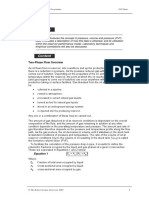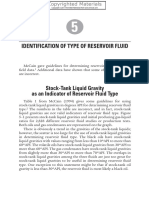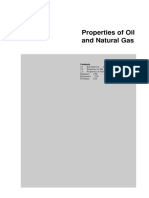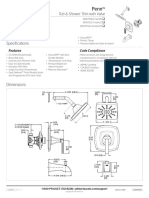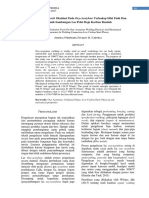06 Volume Conversions
06 Volume Conversions
Uploaded by
farajCopyright:
Available Formats
06 Volume Conversions
06 Volume Conversions
Uploaded by
farajOriginal Description:
Copyright
Available Formats
Share this document
Did you find this document useful?
Is this content inappropriate?
Copyright:
Available Formats
06 Volume Conversions
06 Volume Conversions
Uploaded by
farajCopyright:
Available Formats
Oilphase
Volumetric conversions
Volume conversions
Reservoir (downhole) volumes of oil, gas and water after produced to surface conditions
undergo changes, which affect the fluid volumes as they pass from one set of conditions
to another. These volume changes occur due to the compressibility of the fluids, their
thermal expansion and the solubility of the gases.
Conversion factors are commonly used to account for these changes of the fluid volumes.
The volumes at surface are measured or converted at a standard set of pressure and
temperature conditions, so that they can be universally comparable.
Standard conditions
Gas volumes are expressed in cubic meters (m3) or in standard cubic feet (scf) at 15.56
°C (60 °F) and 1 bar or 1 atmosphere (14.7 psia).
Oil Volumes are expressed in cubic meters (m3) or the API barrels at stock tank conditions
(STB) same reference conditions 15.56 °C (60 °F) and 1 atmosphere (14.7 psia).
Gas-Oil Ratios (GOR) result from the division of the above volumes. Units used are cubic
3 3
meters of oil per cubic meters of oil (m /m ) or standard cubic feet per stock tank barrel
3 3
(scf/STB). GORs can be converted from (m /m ) to scf/STB using the conversion factor
3 3
5.615 (1 scf/STB = 5.615 m /m ).
Formation volume factors
The letter B with a suffix denoting the fluid phase concerned, designates formation
volume factors. Formation volume factor is a function of the fluid composition and of the
pressure and the temperature difference between the downhole and reference (standard)
conditions.
There are three volumetric parameters used in reservoir engineering: Bo, Bg and Bw.
Bo - oil volume factor (or, formation volume factor of oil)
Bg - gas volume factor (or, formation volume factor of gas)
Bw - water volume factor (or, formation volume factor of water)
Reservoir Fluid Behaviour . 1/4
Oilphase
Volumetric conversions
Downhole to surface conversion (for oil reservoir)
Solution
Gas
Solution
SURFACE Gas
Water
Oil
Free
Gas
Gas Water
Oil (Free)
DOWNHOLE
Relationships between surface and downhole volumes - dissolved gas system
The downhole to surface volume relationships are shown graphically above. The total
gas volume collected at surface is the sum of the released gas that it was in solution
downhole plus the gas that it was in free gas state inside the porous media.
Reservoir Fluid Behaviour . 2/4
Oilphase
Volumetric conversions
Oil Formation Volume Factor, Bo
Oil shrinks in volume between downhole and surface conditions, primarily as a result of
the loss of solution gas. The formation volume factor of oil is usually determined by PVT
measurements performed on a live reservoir fluid sample.
Formation Volume Factor for oil (oil volume factor) is equal to:
Oil Volume @ reservoir conditions
Bo =
Oil volume @ standard conditions
A typical range of the formation volume factor for oil (Bo) is 1.2 - 1.6 for low shrinkage
(black) oils and 1.7 4.0 for high shrinkage (volatile) oils.
Being dependent essentially on the amount of dissolved gas, Bo increases with pressure,
up to the bubble point, where all of the available gas is dissolved and then decreases at
a rate determined by the liquid compressibility.
Solubility of natural gas in oil is dependent on the composition of the hydrocarbons, the
temperature and pressure applied. Charts, derived from correlations are also available
to estimate the values for Bo.
Figure below is a typical plot of PVT data for undersaturated oil. Bo increases from
8,000 psia down to the bubble point pressure at 6,350 psia due to the expansion of the
single-phase oil (green line). From 6,350 psia down to atmospheric pressure, increasing
amounts of gas are liberated and therefore Bo decreases.
2000
1800
1600
Compression of liquid after
all gas is in solution
1400 2.4
1200 2.2
1000 2.0
800 1.8
600 1.6
400 1.4
200 1.2
0 1.0
0 1000 2000 3000 4000 5000 6000 7000 8000
Pressure (psia)
o
Typical PVT data for differential vaporisation of an under-saturated oil at constant temperature (305 F)
Reservoir Fluid Behaviour . 3/4
Oilphase
Volumetric conversions
Solution Gas-Oil Ratio, Rs
Rs is defined as the amount of gas in solution at reservoir temperature converted to
standard conditions per unit volume of oil at reservoir conditions converted to standard
conditions.
Dissolved Gas Volume @ standard conditions
Rs =
Residual Oil volume @ standard conditions
Rs is different from producing GOR, since the producing GOR includes also in the
nominator the volume of gas that was in free gas state in the pores of the reservoir.
Total Formation Volume Factor, Bt
When reservoir pressure is reduced below bubble point pressure (pB) some dissolved gas
is released from solution. If the amount of dissolved gas at pB is Rsb and the amount of
dissolved gas remaining in solution at P is Rs, then what has been evolved is (Rsb - Rs)
volume expressed at standard conditions.
pB p<pB
Bg(Rsb-Rs)
Bob
Rsb
Bo
Rs
Oil at pB Released gas & Oil at p
The total formation volume factor Bt (two-phase formation oil factor) may be defined as
the volume in barrels one stock tank barrel and its initial complement of dissolved gas
occupies at any pressure and reservoir temperature.
Therefore:
Bt = Bo + Bg (Rsb − Rs )
Written by: Sylvain Jayawardane (Ph. D., M. Eng.)
Oilphase, Aberdeen.
Reservoir Fluid Behaviour . 4/4
You might also like
- Referencias DynaSand ETAP.01.06Document19 pagesReferencias DynaSand ETAP.01.06ana luciaNo ratings yet
- Lecture-08 - Properties of Reservoir Fluid LiquidsDocument70 pagesLecture-08 - Properties of Reservoir Fluid LiquidsJoy Prokash Roy100% (1)
- PVT Analysis For OilDocument27 pagesPVT Analysis For Oilel hadi100% (1)
- ResEng Flame Ch6Document48 pagesResEng Flame Ch6Caleb Jonatan Montes VelardeNo ratings yet
- Technical Book 612132Document81 pagesTechnical Book 612132faraj100% (3)
- Cost Estimating Budgeting STAP G 1 M 14483Document333 pagesCost Estimating Budgeting STAP G 1 M 14483faraj100% (1)
- Drilling Design Manual STAP P 1 M 6100 Rev1Document232 pagesDrilling Design Manual STAP P 1 M 6100 Rev1farajNo ratings yet
- Oil Properties - 1Document13 pagesOil Properties - 1Driss EddeniaNo ratings yet
- Topic 17 - PVT Properties of Crude OilDocument10 pagesTopic 17 - PVT Properties of Crude OilwevansNo ratings yet
- Fluid Properties: PVT Properties of Crude Oils: 1. Oil Formation Volume Factor, BDocument6 pagesFluid Properties: PVT Properties of Crude Oils: 1. Oil Formation Volume Factor, BAli HijaziNo ratings yet
- SC RE Chap6 LiquidsDocument54 pagesSC RE Chap6 LiquidsweldsvNo ratings yet
- REN5415 - Y19 - Lec13, 14 &15Document87 pagesREN5415 - Y19 - Lec13, 14 &15Abdulla MohammadNo ratings yet
- 5 Oil Properties Part 1Document51 pages5 Oil Properties Part 1Haziq YussofNo ratings yet
- MccainDocument23 pagesMccainCarlos Orley Gil AmayaNo ratings yet
- Reservoir EstimationDocument11 pagesReservoir EstimationRizwan FaridNo ratings yet
- SC-RE Chap6-LiquidsDocument54 pagesSC-RE Chap6-Liquidsb mNo ratings yet
- Petrophysics-Reservoir FluidDocument30 pagesPetrophysics-Reservoir FluidBourhenNo ratings yet
- Intechopen 82278Document23 pagesIntechopen 82278Alex HariucNo ratings yet
- Properties of Crude Oil-01Document90 pagesProperties of Crude Oil-01abdulsamadkhokhar004No ratings yet
- Chapter 2Document16 pagesChapter 2nn1129374No ratings yet
- Feb 8 WeekDocument51 pagesFeb 8 WeekMohammad Iqbal Mahamad Amir100% (2)
- Lecture 2 (AIU)Document34 pagesLecture 2 (AIU)Ahmd SaberNo ratings yet
- Chapter 2Document22 pagesChapter 2nn1129374No ratings yet
- 2 - Oil PropDocument38 pages2 - Oil PropIksan Adityo MulyoNo ratings yet
- ProjectDocument7 pagesProjectSawsen CheboukiNo ratings yet
- Section 2Document36 pagesSection 2fisco4rilNo ratings yet
- 1 Primary Recovery Drive Mechanisms PDFDocument37 pages1 Primary Recovery Drive Mechanisms PDFmd khatriNo ratings yet
- PVT AnalysisDocument40 pagesPVT AnalysisBrian Cbtngn100% (1)
- AFR IntanDocument92 pagesAFR IntanMario Thio KristantoNo ratings yet
- Advancement of Gas Lift in Production OpDocument61 pagesAdvancement of Gas Lift in Production OpGODWIN ANYIMAHNo ratings yet
- Solubility and Displacement Behavior of A Viscous Crude With CO2 and HydrocarboDocument6 pagesSolubility and Displacement Behavior of A Viscous Crude With CO2 and HydrocarboDânChơiNo ratings yet
- Properties of Crude OilDocument58 pagesProperties of Crude OildianeNo ratings yet
- Enhanced Hydrocarbon RecoveryDocument37 pagesEnhanced Hydrocarbon Recoveryبشير أحمد بشير لشهبNo ratings yet
- FluidProperties NotesDocument11 pagesFluidProperties NotesCassio VallinottiNo ratings yet
- Identification of Pitfalls in PVT Gas Condensate Modeling Using Modified Black-Oil FormulationsDocument13 pagesIdentification of Pitfalls in PVT Gas Condensate Modeling Using Modified Black-Oil FormulationsChávez Ibarra Sergio Kevin100% (1)
- Presentación 1Document7 pagesPresentación 1Rafa ElizarrarasNo ratings yet
- Tutorial 2 (RE1)Document9 pagesTutorial 2 (RE1)Fizz MartinNo ratings yet
- PEE 314 Lesson 1Document18 pagesPEE 314 Lesson 1ojigbijojomayeNo ratings yet
- Trisakti 2012 PVT DasarDocument30 pagesTrisakti 2012 PVT DasarJason RojasNo ratings yet
- DF3 - PVT DataDocument10 pagesDF3 - PVT Dataadnan0307No ratings yet
- Pressure-Volume-Temperature For Oil: PVT Analysis - PVT RelationshipDocument21 pagesPressure-Volume-Temperature For Oil: PVT Analysis - PVT RelationshipyerkoNo ratings yet
- PVT Experiments: Differential Liberation:: Reservoir Fluid Properties LabDocument6 pagesPVT Experiments: Differential Liberation:: Reservoir Fluid Properties LabCaptain SurchiNo ratings yet
- Capitulo 5: Pressure-Volume-Temperature For OilDocument21 pagesCapitulo 5: Pressure-Volume-Temperature For OilJosueGuayuscaSoriaGalvarroNo ratings yet
- 1462 - Perilaku Reservoir PerminyakanDocument329 pages1462 - Perilaku Reservoir Perminyakanjazhman100% (1)
- ChaudhriDocument10 pagesChaudhriسحر سلامتیانNo ratings yet
- Art 05 Sep 14 Fluid Classification PVTDocument13 pagesArt 05 Sep 14 Fluid Classification PVTManuel ChNo ratings yet
- 2 - Properties of Oil and Natural Gas - 2007 - Petroleum Production EngineeringDocument9 pages2 - Properties of Oil and Natural Gas - 2007 - Petroleum Production EngineeringHaziq YussofNo ratings yet
- PVT - DR M Idrees - Parts 1 and 2Document49 pagesPVT - DR M Idrees - Parts 1 and 2Vigna Ruban RamNo ratings yet
- Black Oil DefinitionsDocument21 pagesBlack Oil Definitionsmanish.7417No ratings yet
- 2 - Review - of - Reservoir - Fluid - Properties - PDFDocument77 pages2 - Review - of - Reservoir - Fluid - Properties - PDFjoreli100% (1)
- Reservoir Fluid PropertiesDocument11 pagesReservoir Fluid PropertiesTushar LanjekarNo ratings yet
- Reservoir Fluid Properties: A Working Paper in Petroleum Introduction EntitledDocument9 pagesReservoir Fluid Properties: A Working Paper in Petroleum Introduction EntitledAshrafNo ratings yet
- 1 Five Reservoir FluidsDocument30 pages1 Five Reservoir FluidsIndraNafiAkhsaniNo ratings yet
- Reservoir Engineering I: Oil PropertiesDocument25 pagesReservoir Engineering I: Oil PropertiesJoseph YepezNo ratings yet
- Reservoir Engineering Lecture Notes: G.C.EnyiDocument39 pagesReservoir Engineering Lecture Notes: G.C.EnyiRaimundoNo ratings yet
- Res Fluid Props-CorelationsDocument24 pagesRes Fluid Props-CorelationsNivas DonthireddyNo ratings yet
- Lec 3Document7 pagesLec 3Maisam AbbasNo ratings yet
- PETE 216 Reservoir Rock and Fluid PropertiesDocument22 pagesPETE 216 Reservoir Rock and Fluid PropertiesAlparslan KonbulNo ratings yet
- Paper Subject Oil, Water and Gas) : (SaturationDocument9 pagesPaper Subject Oil, Water and Gas) : (Saturationمحمد أحمد عبداللطيفNo ratings yet
- UntitledDocument15 pagesUntitledTural EmirliNo ratings yet
- Black Oil - CompressedDocument46 pagesBlack Oil - CompressedMuh AsharNo ratings yet
- Petroleum Engineering: Principles, Calculations, and WorkflowsFrom EverandPetroleum Engineering: Principles, Calculations, and WorkflowsRating: 5 out of 5 stars5/5 (1)
- Deactivation of Heavy Oil Hydroprocessing Catalysts: Fundamentals and ModelingFrom EverandDeactivation of Heavy Oil Hydroprocessing Catalysts: Fundamentals and ModelingNo ratings yet
- Principle of Kill Method: Well ControlDocument17 pagesPrinciple of Kill Method: Well ControlfarajNo ratings yet
- Well Control: Choke Manifold and ValvesDocument4 pagesWell Control: Choke Manifold and ValvesfarajNo ratings yet
- Leak Off Procedure: Well ControlDocument7 pagesLeak Off Procedure: Well ControlfarajNo ratings yet
- Reason For Shut In: Well ControlDocument9 pagesReason For Shut In: Well ControlfarajNo ratings yet
- Ring Gasket Types: Well ControlDocument3 pagesRing Gasket Types: Well ControlfarajNo ratings yet
- Well Control: BOP Accumulator Unit (Koomey Unit)Document12 pagesWell Control: BOP Accumulator Unit (Koomey Unit)faraj100% (2)
- Explosives: Schlumberger Field Safety ProceduresDocument1 pageExplosives: Schlumberger Field Safety ProceduresfarajNo ratings yet
- Cementing & Casing Accessories Davis-Lynch Equipment CatalogDocument19 pagesCementing & Casing Accessories Davis-Lynch Equipment CatalogfarajNo ratings yet
- Cementing Procedures: Second Stage Cementing With Single Plug SystemDocument3 pagesCementing Procedures: Second Stage Cementing With Single Plug SystemfarajNo ratings yet
- Davis-FET CatalogDocument19 pagesDavis-FET CatalogfarajNo ratings yet
- English For Libya WorkBookDocument104 pagesEnglish For Libya WorkBookfarajNo ratings yet
- Fundamental Manual First RevisionDocument34 pagesFundamental Manual First RevisionfarajNo ratings yet
- Casing Design ManualDocument124 pagesCasing Design Manualfaraj50% (2)
- Saravana EngineeringDocument7 pagesSaravana EngineeringForesight SolutionsNo ratings yet
- IMPULSE Heating System DesignDocument232 pagesIMPULSE Heating System DesignAshique Muhammed T MNo ratings yet
- Assignment 1Document2 pagesAssignment 1Raja HindustaniNo ratings yet
- Heat Transfer by Wavy MicrochannelDocument9 pagesHeat Transfer by Wavy MicrochannelAnkit LonareNo ratings yet
- 9 - Horizontal Flare Knock Out Drum Sizing1Document2 pages9 - Horizontal Flare Knock Out Drum Sizing1Anonymous APc7I7100% (2)
- Chapter 9. Air Compressor: Subject: Basic Mechanical Engineering (3110006)Document12 pagesChapter 9. Air Compressor: Subject: Basic Mechanical Engineering (3110006)Aizaz MuhammadNo ratings yet
- Gland Seal Water SPOOL 1.5": AREA: 3510Document12 pagesGland Seal Water SPOOL 1.5": AREA: 3510JHONATAN RODRIGUEZ VENTONo ratings yet
- Chapter4 Water ChemistryDocument15 pagesChapter4 Water ChemistryAnindya SenNo ratings yet
- Ss 8p8 PesxDocument1 pageSs 8p8 PesxJimmyNo ratings yet
- Rainwater Harvesting System - WaterCare InternationalDocument5 pagesRainwater Harvesting System - WaterCare InternationalEdwin Ramos PolicarpioNo ratings yet
- Liebherr A380 Air Management PosterDocument1 pageLiebherr A380 Air Management PosterSathiya SeelanNo ratings yet
- Gibbs Reactor Simulation in Chemcad: Al-Nahrain University Collage of Engineerng Chamical Engineering Departement ChemcadDocument8 pagesGibbs Reactor Simulation in Chemcad: Al-Nahrain University Collage of Engineerng Chamical Engineering Departement Chemcadنزار الدهاميNo ratings yet
- Lab ReportDocument11 pagesLab ReportKarthick MurugesanNo ratings yet
- Chapter Two: Pipe Flow Hydraulics: Hydraulics-II Lecture NotesDocument27 pagesChapter Two: Pipe Flow Hydraulics: Hydraulics-II Lecture NotesErmiyas AlhegnNo ratings yet
- Datasheet Joint Isolant 4'' #300 PDFDocument1 pageDatasheet Joint Isolant 4'' #300 PDFseifNo ratings yet
- Water Distribution System OperationDocument10 pagesWater Distribution System OperationSCR_010101No ratings yet
- 4way Diverter CatalogueDocument10 pages4way Diverter CatalogueMohd Khairi Mohd NorzianNo ratings yet
- EVT524 Lab 2Document5 pagesEVT524 Lab 2Nur AqilahNo ratings yet
- 06 Volume ConversionsDocument4 pages06 Volume ConversionsfarajNo ratings yet
- Determination The Invert Level of A Stilling Basin To Control Hydraulic Jump-1Document6 pagesDetermination The Invert Level of A Stilling Basin To Control Hydraulic Jump-1anon_459056029No ratings yet
- Adsorption For Wastewater Treatment and Water Purification: Basic Knowledge On Adsorption Process and Types of AdsorbentsDocument16 pagesAdsorption For Wastewater Treatment and Water Purification: Basic Knowledge On Adsorption Process and Types of AdsorbentsHenryPeñaNo ratings yet
- Jurnal Las GasDocument8 pagesJurnal Las GasMuhammad Zaenal ArifinNo ratings yet
- Calculation Sheet For Centrifugal Pumps: Excel Program File: Pumpmast - Xls Version: 1.02 / RehDocument9 pagesCalculation Sheet For Centrifugal Pumps: Excel Program File: Pumpmast - Xls Version: 1.02 / RehCast Ed IvNo ratings yet
- Me 2351 Gas Dynamics and Jet PropulsionDocument2 pagesMe 2351 Gas Dynamics and Jet PropulsionMohanraj SubramaniNo ratings yet
- Thin Airfoil TheoryDocument39 pagesThin Airfoil Theorymscafe0% (1)
- Izzatun Nazurah Binti Zaimuddin - FBHDocument14 pagesIzzatun Nazurah Binti Zaimuddin - FBHNor' AzahNo ratings yet
- O0176A-M-V41562-01 Sheet 1 Rev.0Document1 pageO0176A-M-V41562-01 Sheet 1 Rev.0DarioNo ratings yet
- Regulator With NRVDocument2 pagesRegulator With NRVBiswanath LenkaNo ratings yet
- Dash 8 400 Sys Desc Handout - HydDocument128 pagesDash 8 400 Sys Desc Handout - Hydsolomon.mehrettNo ratings yet







































